As children across Europe and North America return to classrooms this month, the majority of Sudan’s school-age children remain at home or in temporary shelters, with many at risk of never completing their education, according to Save the Children.
The aid group’s analysis of Global Education Cluster data reveals that 13 million of Sudan’s 17 million school-age children are currently out of school, highlighting one of the world’s most severe education crises.
This figure includes about seven million children who are enrolled but unable to attend school due to conflict or displacement, and six million children who are not enrolled at all, facing the possibility of losing access to education entirely.
All 13 million children, more than the entire population of Belgium, have missed at least a full year of school since April 2023.
Even before the outbreak of violence, nearly seven million children in Sudan were already out of school due to poverty and instability.
Recent months have seen just under half of Sudan’s schools reopen, allowing four million children to return to learning. However, mass displacement, shortages of teachers and learning materials, and restricted access continue to block many children from classrooms.
About 55 percent of schools remain closed, with roughly one in ten now housing displaced families.
The threat of flooding during September and October, with above-average rainfall, further endangers school infrastructure and disrupts education.
Razan, a 10-year-old girl from Khartoum, was forced to flee her home when conflict broke out, missing an entire academic year.
Now settled in a village near Sinjai, southeast of the capital, she has returned to school: "When we first left Khartoum, I thought we would go back home after a few days. I kept asking my father, 'When will we go back to my school?'. I was hurt to lose a year of school. I missed my friends and my classroom so much. I don’t want any more wars. I just want to wear my backpack every morning and go learn new things."
Sudan is experiencing one of the world’s most severe humanitarian crises, with the highest numbers of displaced people and some regions facing famine conditions.
By July 2025, nearly 9.9 million people had been forcibly displaced.
Save the Children is calling on the international community to push for a ceasefire to allow safe humanitarian access and a significant increase in aid that could help children return to school.
Mohamed Abdiladif, Country Director for Save the Children in Sudan, emphasized:" Education is so easily dismissed in a crisis as a lower priority, but as a conflict drags on, children’s core learning years pass by – years they can never get back,"
Save the Children runs education programs in nine states across Sudan, supporting over 400 schools.
These programs include school feeding, school gardens, and the provision of notebooks, uniforms, and essential learning supplies.
Schools are also rehabilitated with safe water and sanitation facilities, while teachers receive wages, training, and psychosocial support to help students cope with the trauma of conflict and displacement.

